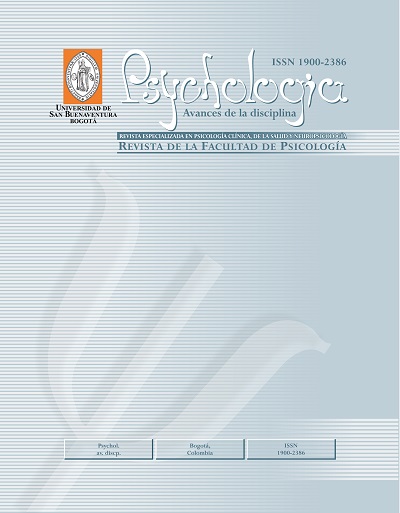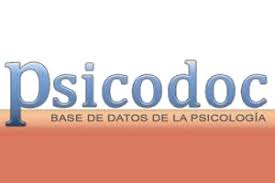This journal provides open, immediate access to its contents, based on the principle that offering the public free access to research helps to promote a higher global exchange of knowledge.
As such, all journal articles are published under a Creative Commons Attribution-NonCommercial-ShareAlike 4.0 International License (CC BY-NC-SA), by which commercial use of the original work or its possible derived works is not allowed, and the distribution thereof must be done with the same license elements regulating the original work.
http://creativecommons.org/licenses/by-nc-sa/4.0/
Abstract
La discriminación de las emociones expresadas a nivel facial es importante para las relaciones sociales, la empatía y la interacción social. El objetivo de este estudio fue observar si existían diferencias en el procesamiento cortical ante dos emociones básicas, la ira y el miedo y definir si la percepción de la ira intensa genera una mayor modulación del componente N170 en amplitud y latencia en comparación con las imágenes de rostros con expresión de miedo intenso. Para este estudio se utilizó la técnica de potenciales evocados con un montaje de 32 canales. Se encontraron diferencias significativas en latencia para las imágenes de rostros que expresan ira intensa, comparados con la condición de imágenes de rostros de miedo intenso. Se encontraron diferencias tanto de la amplitud como de latencia ante imágenes de rostros de ira y miedo intensos en comparación con imágenes de rostros neutros.
References
Baggott, S., Palermo, R., & Fox, A. M. (2011). Processing emotional category congruency between emotional facial expressions and emotional words. Cognition & Emotion, 25(2), 369–379. doi: 10.1080/02699931.2010.488945
Batty, M., & Taylor, M. J. (2003). Early processing of the six basic facial emotional expressions. Cognitive Brain Research, 17(3), 613–620. doi: 10.1016/S0926-6410(03)00174-5
Bentin, S., Allison, T., Puce, A., Perez, E., & McCarthy, G. (1996). Electrophysiological Studies of Face Perception in Humans. Journal of Cognitive Neuroscience, 8(6), 551–565. doi: 10.1162/jocn.1996.8.6.551
Blair, R. J. R., Morris, J. S., Frith, C. D., Perrett, D. I., & Dolan, R. J. (1999). Dissociable neural responses to facial expressions of sadness and anger. Brain, 122(5), 883–893. doi: 10.1093/brain/122.5.883
Blau, V. C., Maurer, U., Tottenham, N., & McCandliss, B. D. (2007). The face-specific N170 component is modulated by emotional facial expression. Behavioral and Brain Functions, 3(7). doi: 10.1186/1744-9081-3-7
Blechert, J., Sheppes, G., Di Tella, C., Williams, H., & Gross, J. J. (2012). See what you think: Reappraisal modulates behavioral and neural responses to social stimuli. Psychological Science, 23(4), 346–353. doi: 10.1177/0956797612438559
Brenner, C. A., Rumak, S. P., Burns, A. M. N., & Kieffaber, P. D. (2014). The role of encoding and attention in facial emotion memory: An EEG investigation. International Journal of Psychophysiology, 93(3), 398–410. doi: 10.1016/j.ijpsycho.2014.06.006
Britton, J. C., Shin, L. M., Barrett, L., Rauch, S. L., & Wright, C. I. (2008). Amygdala and fusiform gyrus temporal dynamics: Responses to negative facial expressions. BMC Neuroscience, 9(44). doi: 10.1186/1471-2202-9-44
Caharel, S., Courtay, N., Bernard, C., Lalonde, R., & Rebaï, M. (2005). Familiarity and emotional expression influence an early stage of face processing: An electrophysiological study. Brain and Cognition, 59(1), 96–100. doi: 10.1016/j.bandc.2005.05.005
Calvo, M. G., & Beltrán, D. (2013). Recognition advantage of happy faces: Tracing the neurocognitive processes. Neuropsychologia, 51(11), 2051–2061. doi: 10.1016/j.neuropsychologia.2013.07.010
Chen, J., Zhong, J., Zhang, Y., Li, P., Zhang, A., Tan, Q., & Li, H. (2012). Electrophysiological correlates of processing facial attractiveness and its influence on cooperative behavior. Neuroscience Letters, 517(2), 65–70. doi: 10.1016/j.neulet.2012.02.082
Eimer, M. (2000). The face-specific N170 component reflects late stages in the structural encoding of faces. Neuroreport, 11(10), 2319–2324. doi: 10.1097/00001756-200007140-00050
Eimer, M., & Holmes, A. (2002). An ERP study on the time course of emotional face processing. Neuroreport, 13(4), 427–431. doi: 10.1097/00001756-200203250-00013
Fitzgerald, D. A., Angstadt, M., Jelsone, L. M., Nathan, P. J., & Phan, K. L. (2006). Beyond threat: Amygdala reactivity across multiple expressions of facial affect. NeuroImage, 30(4), 1441–1448. doi: 10.1016/j.neuroimage.2005.11.003
Frühholz, S., Jellinghaus, A., & Herrmann, M. (2011). Time course of implicit processing and explicit processing of emotional faces and emotional words. Biological Psychology, 87(2), 265–274. doi: 10.1016/j.biopsycho.2011.03.008
Gratton, G., Coles, M. G. ., & Donchin, E. (1983). A new method for off-line removal of ocular artifact. Electroencephalography and Clinical Neurophysiology, 55(4), 468–484. doi: 10.1016/0013-4694(83)90135-9
Herrington, J. D., Taylor, J. M., Grupe, D. W., Curby, K. M., & Schultz, R. T. (2011). Bidirectional communication between amygdala and fusiform gyrus during facial recognition. NeuroImage, 56(4), 2348–2355. doi: 10.1016/j.neuroimage.2011.03.072
Itier, R. J., & Taylor, M. J. (2002). Inversion and contrast polarity reversal affect both encoding and recognition processes of unfamiliar faces: A repetition study using ERPs. NeuroImage, 15(2), 353–372. doi: 10.1006/nimg.2001.0982
Jacques, C., & Rossion, B. (2010). Misaligning face halves increases and delays the N170 specifically for upright faces: Implications for the nature of early face representations. Brain Research, 1318, 96–109. doi: 10.1016/j.brainres.2009.12.070
Leppänen, J. M., Kauppinen, P., Peltola, M. J., & Hietanen, J. K. (2007). Differential electrocortical responses to increasing intensities of fearful and happy emotional expressions. Brain Research, 1166, 103–109. doi: 10.1016/j.brainres.2007.06.060
Luo, W., Feng, W., He, W., Wang, N.-Y., & Luo, Y.-J. (2010). Three stages of facial expression processing: ERP study with rapid serial visual presentation. NeuroImage, 49(2), 1857–1867. doi: 10.1016/j.neuroimage.2009.09.018
Lu, Y., Wang, J., Wang, L., Wang, J., & Qin, J. (2014). Neural responses to cartoon facial attractiveness: An event-related potential study. Neuroscience Bulletin, 30(3), 441–450. doi: 10.1007/s12264-013-1401-4
Marzi, T., & Viggiano, M. P. (2010). When memory meets beauty: Insights from event-related potentials. Biological Psychology, 84(2), 192–205. doi: 10.1016/j.biopsycho.2010.01.013
Maurer, D., Grand, R. Le, & Mondloch, C. J. (2002). The many faces of configural processing. Trends in Cognitive Sciences, 6(6), 255–260. doi: 10.1016/S1364-6613(02)01903-4
McBain, R., Norton, D., & Chen, Y. (2009). Females excel at basic face perception. Acta Psychologica, 130(2), 168–173. doi: 10.1016/j.actpsy.2008.12.005
Milivojevic, B., Clapp, W. C., Johnson, B. W., & Corballis, M. C. (2003). Turn that frown upside down: ERP effects of thatcherization of misorientated faces. Psychophysiology, 40(6), 967–978. doi: 10.1111/1469-8986.00115
Morris, J. S., Friston, K. J., Büchel, C., Frith, C. D., Young, A. W., Calder, A. J., & Dolan, R. J. (1998). A neuromodulatory role for the human amygdala in processing emotional facial expressions. Brain, 121(1), 47–57. doi: 10.1093/brain/121.1.47
Muñoz, F., & Martín-Loeches, M. (2015). Electrophysiological brain dynamics during the esthetic judgment of human bodies and faces. Brain Research, 1594, 154–164. doi: 10.1016/j.brainres.2014.10.061
Oldfield, R. C. (1971). The assessment and analysis of handedness: The Edinburgh inventory. Neuropsychologia, 9(1), 97–113. doi: 10.1016/0028-3932(71)90067-4
Rossion, B., Gauthier, I., Tarr, M. J., Despland, P., Bruyer, R., Linotte, S., & Crommelinck, M. (2000). The N170 occipito-temporal component is delayed and enhanced to inverted faces but not to inverted objects: an electrophysiological account of face-specific processes in the human brain. Neuroreport, 11(1), 69–74. doi: 10.1097/00001756-200001170-00014
Ruxton, G. D., & Beauchamp, G. (2008). Time for some a priori thinking about post hoc testing. Behavioral Ecology, 19(3), 690–693. doi: 10.1093/beheco/arn020
Sadeh, B., & Yovel, G. (2010). Why is the N170 enhanced for inverted faces? An ERP competition experiment. NeuroImage, 53(2), 782–789. doi: 10.1016/j.neuroimage.2010.06.029
Schacht, A., Werheid, K., & Sommer, W. (2008). The appraisal of facial beauty is rapid but not mandatory. Cognitive, Affective & Behavioral Neuroscience, 8(2), 132–142. doi: 10.3758/CABN.8.2.132
Sergent, J., Ohta, S., Macdonald, B., & Zuck, E. (1994). Segregated processing of facial identity and emotion in the human brain: A PET study. Visual Cognition, 1(2), 349–369. doi: 10.1080/13506289408402305
Smith, E., Weinberg, A., Moran, T., & Hajcak, G. (2013). Electrocortical responses to NIMSTIM facial expressions of emotion. International Journal of Psychophysiology, 88(1), 17–25. doi: 10.1016/j.ijpsycho.2012.12.004
Sprengelmeyer, R., & Jentzsch, I. (2006). Event related potentials and the perception of intensity in facial expressions. Neuropsychologia, 44(14), 2899–2906. doi: 10.1016/j.neuropsychologia.2006.06.020
Werheid, K., Schacht, A., & Sommer, W. (2007). Facial attractiveness modulates early and late event-related brain potentials. Biological Psychology, 76(1-2), 100–108. doi: 10.1016/j.biopsycho.2007.06.008
Young, A. W., Perrett, D. I., Calder, A. J., Sprengelmeyer, R., & Ekman, P. (2001). Facial expressions of emotion: Stimuli and tests (FEEST). Bury St Edmunds, UK: Thames Valley Test Company.





















